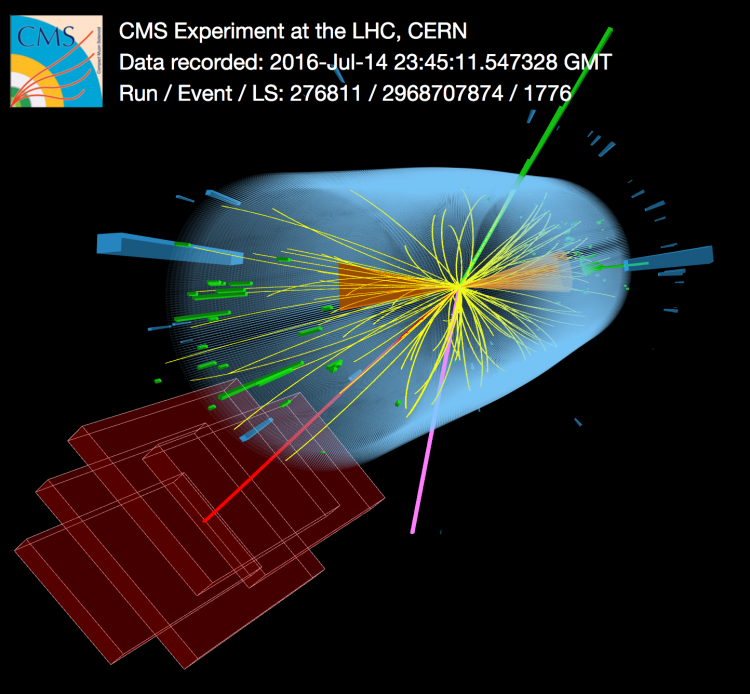
For the first time, CMS physicists have investigated an effect called the “running” of the top quark mass, a fundamental quantum effect predicted by the Standard Model.
Mass is one of the most complex concepts in fundamental physics, which went through a long history of conceptual developments. Mass was first understood in classical mechanics as a measure of inertia and was later interpreted in the theory of special relativity as a form of energy. Mass has a similar meaning in modern quantum field theories that describe the subatomic world. The Standard Model of particle physics is such a quantum field theory, and it can describe the interaction of all known fundamental particles at the energies of the Large Hadron Collider.
Quantum Chromodynamics is the part of the Standard Model that describes the interactions of fundamental constituents of nuclear matter: quarks and gluons. The strength of the interaction between these particles depends on a fundamental parameter called the strong coupling constant. According to Quantum Chromodynamics, the strong coupling constant rapidly decreases at higher energy scales. This effect is called asymptotic freedom, and the scale evolution is referred to as the "running of the coupling constant." The same is also true for the masses of the quarks, which can themselves be understood as fundamental couplings, for example, in connection with the interaction with the Higgs field. In Quantum Chromodynamics, the running of the strong coupling constant and of the quark masses can be predicted, and these predictions can be experimentally tested.
The experimental verification of the running mass is an essential test of the validity of Quantum Chromodynamics. At the energies probed by the Large Hadron Collider, the effects of physics beyond the Standard Model could lead to modifications of the running of mass. Therefore, a measurement of this effect is also a search for unknown physics. Over the past decades, the running of the strong coupling constant has been experimentally verified for a wide range of scales. Also, evidence was found for the running of the masses of the charm and beauty quarks.

Figure 1: Display of an LHC collision detected by the CMS detector that contains a reconstructed top quark-antiquark pair. The display shows an electron (green) and a muon (red) of opposite charge, two highly energetic jets (orange) and a large amount of missing energy (purple).
With a new measurement, the CMS Collaboration investigates for the first time the running of the mass of the heaviest of the quarks: the top quark. The production rate of top quark pairs (a quantity that depends on the top quark mass) was measured at different energy scales. From this measurement, the top quark mass is extracted at those energy scales using theory predictions that predict the rate at which top quark-antiquark pairs are produced.

Figure 2: The running of the top quark mass determined from the data (black points) compared to the theoretical prediction (red line). As the absolute scale of the top quark mass is not relevant for this measurement, the values have been normalised to the second data point.
Experimentally, interesting top quark pair collisions are selected by searching for the specific decay products of a top quark-antiquark pair. In the overwhelming majority of cases, top quarks decay into an energetic jet and a W boson, which in turn can decay into a lepton and a neutrino. Jets and leptons can be identified and measured with high precision by the CMS detector, while neutrinos escape undetected and reveal themselves as missing energy. A collision that is likely the production of a top quark-antiquark pair as it is seen in the CMS detector is shown in Figure 1. Such a collision is expected to contain an electron, a muon, two energetic jets, and a large amount of missing energy.
The measured running of the top quark mass is shown in Figure 2. The markers correspond to the measured points, while the red line represents the theoretical prediction according to Quantum Chromodynamics. The result provides the first indication of the validity of the fundamental quantum effect of the running of the top quark mass and opens a new window to test our understanding of the strong interaction. While a lot more data will be collected in the future LHC runs starting with Run 3 in 2021, this particular CMS result is mostly sensitive to uncertainties coming from the theoretical knowledge of the top quark in Quantum Chromodynamics. To witness the top quark mass running with even higher precision and maybe unveil signs of new physics, theory developments and experimental efforts will both be necessary. In the meantime, watch the top quark run!
Read more about these results in the CMS Physics Analysis Summaries:
- Log in to post comments

